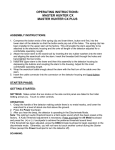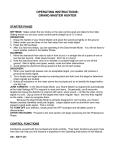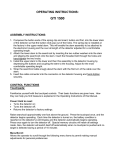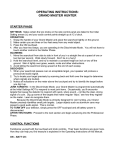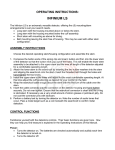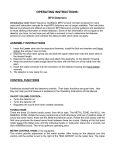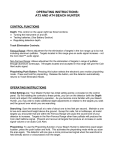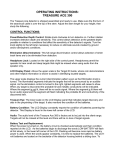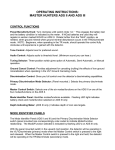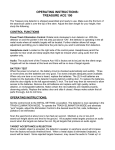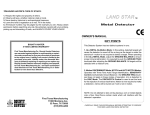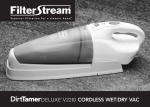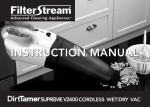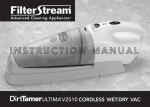Download Garrett Metal Detectors SEA HUNTER MARK ll User's Manual
Transcript
OPERATING INSTRUCTIONS: SEA HUNTER MARK ll The Sea hunter Mark ll is an extremely versatile detector, offering four (4) mounting/stem arrangements to suit your search needs. • Long stem with the housing mounted above the stem. • Long stem with the housing mounted below the cuff assembly. • Short stem with mounting as above for diving. • Belt mounting leaving the stem free of housing. This may be used with either stem configuration. ASSEMBLY INSTRUCTION Choose the desired operating stem/housing configuration and assemble the stem. 1. Compress the button ends of the spring clip and insert, button end first, into the lower stem of the detector so that the button ends pop out of the holes. This will enable the lower stem assembly to be attached to the upper stem and the over all length of the detector adjusted for a comfortable operating length. 2. Attach the lower stem to the searchcoil by inserting the two rubber washers into the stem and slipping the searchcoil onto the stem. Insert the threaded bolt through the holes and hand-tighten the two knobs. 3. Install the upper stem to the lower and adjust for the most comfortable operating length. 4. Wrap the searchcoil cable snugly about the stem with the first turn of the cable over the stem. 5. Insert the cable connector into the connector on the detector housing and hand-tighten securely. Do not over tighten. Ensure that the searchcoil connector is clean and the o-ring is lubricated. If necessary use a very small amount of silicon grease or petroleum jelly. Do not coat the connector pins with lubricant. 6. Perform a battery test by turning the detector on. Note the number of audio tones that occur. Pass a metal target such as a coin beneath the searchcoil to confirm metal detection. CONTROL FUNCTIONS Familiarize yourself with the detectors controls. Their basic functions are given here. How they can help you find treasure is explained in the Operating Instructions of this Manual. Power/ Depth: • Turns the detector on. The batteries are checked automatically and audibly each time the detector is turned on. • Turns the detector off. • Selects either of the two (2) search modes. Raise searchcoil approximately one foot above the ground. Rotate this knob to turn the detector on and the detector begins operating. Each time the detector is turned on the battery condition is reported audibly. Three or more tones indicate the batteries are very good, two tones indicate the batteries are adequate. One tone or no tone indicate the batteries need to be replaced. Audio: This control on the lower left of the detector panel allows the operator to adjust precisely the level of sound generated by the detector. It is suggested that this sound level be adjusted to a threshold level where it is barely audible when searching. Elimination Control: Located on the upper left of the detector faceplate panel. Used with either of the two Trash Elimination modes to choose the level of trash rejection appropriate to your search needs. As the control knob is rotated clockwise more items are eliminated from detection. Headphone Jack: Located on the upper right of the detector panel. Underwater headphones are included with the detector. SEARCH MODES Standard Trash Elimination and Discrete Trash Elimination are the search modes available on the Sea Hunter Mark ll. The selector switch for these modes is included with the Power Control on the lower right of the detector panel. Standard Trash Elimination: This is the search mode normally available on conventional pulse induction (PI) detectors. In this mode the background audio threshold is continuous and remains close to the level established by the operator. Some slight variation of the audio level is normal. Small or deep targets produce faint and weak signals; large or shallow targets produce loud, strong audio signals. The Elimination Control, as rotated clockwise, decreases the detectors response to metals discovered. Poor conductors such as foil, nickel, and pulltabs are eliminated from detection much lower on the scale than good conductors like coins and most jewelry. Poor conductors can be effectively eliminated from detection, however some response may be heard if these items are near the searchcoil during your search. Jewelry is generally located in the middle of the conductive range so it is important to use no more trash elimination than necessary. Most successful detectorists accept all targets of the conductivity of a US nickel or better. Trash items can always be discarded when the hunt is over. The Standard Trash Elimination mode permits a very slow scan speed that makes it particularly effective for pinpointing targets. This mode also provides the deepest possible detection depth and is most useful in areas with little trash. Discrete Trash Elimination: This search mode is exclusive to the Sea Hunter Mark ll. It is similar in operation to the Motion Discrimination mode in that it provides more precise and enhanced target discrimination. The background audio threshold remains at the chosen level until an “accepted” target is presented to the searchcoil. At that time a sharp audio response, a characteristic of all motion detectors, occurs. As with the Standard mode, the Elimination Control is used to change the detectors ability to detect various types of metal; poor conductors can be eliminated while only slightly reducing the detection of better conductors. Although the Discrete mode appears to achieve less detection depth in air tests its ability to eliminate undesirable items precisely, without affecting desirable items, enables it to outperform the Standard mode in certain situations. For example, with the elimination control set to exclude pulltabs, they are excluded with little or no effect on the detection response to most thin gold rings. To pinpoint in the Discrete mode, sweep the searchcoil over the target. The searchcoil must remain in motion to produce an audio response. This mode is designed to provide superior pulse induction target discrimination and is especially useful in areas with a lot of trash OPERATING INSTRUCTIONS The following procedure shows just how easy it is to operate the Sea Hunter Mark ll detector. 1. Turn on the detector and note the results of the automatic battery check represented by number of audio tones. Four tones indicate the batteries are good, two or three tones indicate they are adequate. When one tone or no tone is sounded, replace the batteries. 2. Select either the Standard or Discrete Trash Elimination operating mode. 3. Adjust the threshold audio level to the desired setting. Typically this level is set to the point that the threshold sound is just audible, barely above being silent. 4. Set the Elimination Control to zero or at least a very low level until you can determine the types and amount of trash metal is present. Eliminate only the minimum amount of items to insure that all acceptable targets are located to maximize your search goals. Searching: Scan the searchcoil at a speed of about one to two feet per second at a distance from the ground of about one to two inches. An audio increase will indicate the presence of metal beneath the coil. Pinpointing and Target Recovery: When the detector locates a target you must recover it to see what has been found. Pinpoint the target by making an imaginary “X” over the target. Where the loudest sound is, the target will be beneath the searchcoil. You may wish to switch into the Standard mode to enable you to hover over the target, because in the Discrete mode searchcoil motion is required to recognize the targets presence. The final step is recovery and digging is usually involved. Always make as small a hole as possible and always fill your holes when the target has been recovered. Use the proper tool for the type of hunting you are doing. Recheck your hole for additional targets. Batteries: The Sea Hunter Mark ll requires eight (8) AA batteries. When replacements are required use only high quality carbon, alkaline or rechargeable batteries. Each time the detector is turned on the batteries are checked automatically and audibly. Four or more tones indicate the batteries are very good, two tones indicate the batteries are adequate. One tone or no tone indicates the batteries should be replaced. Battery Replacement: The batteries are located inside the electronic housing with access at the rear of the housing. To access the batteries, unscrew the battery cap at the rear of the detector housing by hand; DO NOT use tools. The o-ring should remain in the control housing while the battery pack slides out. When installing batteries ensure that the correct polarity is observed. Re-install the battery pack by placing the contact end of the pack in the housing with the contacts down. Verify that the o-ring is well lubricated and free from debris. Add a little silicone grease or petroleum jelly if necessary. Re-install the battery cap, hand tightening it until it is flush with the housing and the two index marks are aligned. Note: Always use high quality batteries such as Alkaline or nickel metal hydride in this detector. And, always remove them from the detector and the battery holder when storing the detector for long periods. . SEARCHCOILS: The Sea Hunter Mark ll has two searchcoils available for its use. The 8” searchcoil, which provides excellent depth and good scanning width, is the most popular size used for general searching in all areas. This searchcoil should be used for your primary searching. The 10 x 14” Elliptical searchcoil offers the ability to cover more area and search at a greater depth, particularly for larger targets. Cautions: 1. If the battery compartment becomes flooded, remove the batteries immediately, rinse the compartment with fresh water and allow it air dry. The electronic compartment is factory sealed and should never be opened; the see-through “helmet-mask” on the front panel should remain free and clear from condensation. If the window ever displays moisture, contact the Garrett factory as soon as possible. 2. Before diving always examine the searchcoil and headphone connectors and the battery cap. Verify the battery strength by operating the detector for a few moments prior to field use. 3. Dive with extreme caution. Observe diving practices to lessen the risks of becoming entangled with the headphone or searchcoil cables. Ensure that the headphone vent holes are open prior to diving. 4. When using the hip mount configuration while diving, ensure that the belt will not interfere with equipment removal in the event of an emergency. OPERATING RECOMMENDATIONS As you operate and use your Garrett detector, you will quickly grow more proficient in its use. It is recommended that you build your own test plot. Bury several items, including a nail, a piece of foil, a pulltab, a bottlecap and several coins at depths of about two to eight inches and a foot apart. Clearly mark the location where each article is buried. Practice scanning the targets while listening to and studying the detection signals. Remember that newly buried objects, especially coins, will be somewhat more difficult to detect than items that have been buried for some time. This is primarily a metallurgical phenomenon. Experiment with the various operating modes to see how your detector responds. Practice trying to pinpoint and locate targets precisely. When scanning, do not hurry. Scan the searchcoil at a speed of about one to two feet per second. Keep the searchcoil flat and level to the ground. Move it back and forth slowly and steadily while you walk at a pace that is comfortable. Be methodical. Do not skip any areas. Wear headphones for greater sound perception and concentrate on your scanning. After you have operated your Sea Hunter Mark ll for only a short time, you will be surprised at how proficient you have become in its use. Do not expect to achieve the greatest accuracy and success, however, until you have operated the detector for at least 100 hours or more. Good hunting! MAINTENANCE Always remember that your Garrett detector is a sensitive electronic instrument. It is built to withstand rugged treatment in the outdoors, but you should always handle the detector as carefully as possible. Try to avoid temperature extremes as much as possible, such as storing the detector in an automobile trunk during hot summer months or outdoors in sub-freezing weather. Keep your detector clean. Always wipe the housing after use, and wash the coil when necessary. Disassemble the stem and wipe it clean after use in sandy areas. When storing longer that about one month, remove batteries from the detector. REPAIR SERVICE In case of difficulty, read this Owner’s Manual again thoroughly to make certain your detector is not inoperable needlessly. Your dealer may also be able to offer advice. When your detector must be returned to the factory for service, always include a letter that describes its problem as fully as possible. Before you return your detector to the Garrett factory, make certain: You have read this Owner’s Manual carefully You have checked batteries, switches and connectors. (Check batteries especially closely. They are the most common cause of detector “failure”.) You have checked with your dealer, particularly if you are not familiar with this type of metal detector. You have included a note with the detector describing the problems you are encountering with this detector and conditions under which they occur. Make certain to include your name, address and a phone number where you can be contacted between 8:30 a.m. and 4 p.m., Central Time. You have carefully packed the detector in its original shipping carton or other suitable box. Make certain that proper insulation or packing material is used to keep all parts secure. Do not ship stems or headphones unless they are part of the problem. Be certain to return all coils, unless the problem is mechanical. Ship to Garrett Metal Detectors, 1881 W. State St., Garland, TX 75042. You can call Garrett’s Customer Service Department (972-494-6151) if you have further questions. Please allow approximately one week for Garrett technicians to examine and repair your detector after they receive it, plus another week for return shipping to you. All equipment will be returned UPS or parcel post unless written authorization is given by you to ship collect by air parcel post, UPS Blue (air) or air freight. MIND YOUR MANNERS Filling holes and obeying no trespassing signs are but two requirements of a dedicated metal detector hobbyist. A sincere request that Charles Garrett makes to every user of one of his detectors is that each place searched be left in a better condition than it was found. Thousands of individuals and organizations have adopted this formal Metal Detector Operators Code of Ethics: I will respect private and public property, all historical and archaeological sites and will do no metal detecting on these lands without proper permission. I will keep informed on and obey all laws, regulations and rules governing federal, state and local public lands. I will aid law enforcement officials whenever possible. I will cause no willful damage to property of any kind, including fence, signs and buildings and will always fill holes I dig. I will not destroy property, buildings or the remains of ghost towns and other deserted structures. I will not leave litter or uncovered items lying around. I will carry all trash and dug targets with me when I leave each search area. I will observe the Golden Rule, using good outdoor manners and conducting myself at all times in a manner which will add to the stature and public image of all people engaged in the field of metal detection. WARNING! Any metal detector may discover underground power lines; explosives or other items which when struck could cause personal injury. When searching for treasure with your Sea Hunter Mark ll, observe these precautions: Do not hunt in an area where you believe there may be shallowly buried underground electric lines or pipes. Do not hunt in a military zone where bombs or other explosives may be buried. Avoid striking any line known to be or suspected to be carrying electrical power. Do not disturb any pipeline, particularly if it could be carrying flammable gas or liquid. Use reasonable caution in digging toward any target, particularly in areas where you are uncertain of underground conditions. PATENT PROTECTION: Proof of Garrett’s excellence is the recognition given them by the following United States patents: 4,709,213; 4,488,115; 4,700,139; 4,398,104; 4,423,377; 4,303,879; 4,334,191; 3,662,255; 4,162,969; 4,334,192; 5,148,151; 5,138,262; 5,721,489; 5,786,696; 5,969,528; Design 274,704 and 297,221; Design 333,990; G.B. Design 2,011,852; Australia Design 111,674 and other patents pending.







